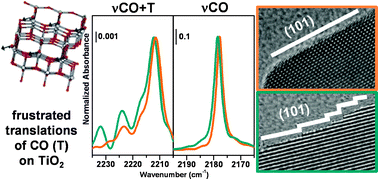Integrated studies of CO adsorption on TiO2 materials of different morphology and surface complexity identify, for the first time, frustrated translational CO modes by detecting their combination with the CO stretching mode (νCO). All the considered materials exhibit IR spectra with low-intensity bands in the 2235–2205 cm−1 range, a region where components due to strong Lewis acid Ti4+ sites may be present as well. These observations lead to a powerful method for associating high-wavenumber bands to TiO2 surface features and interpreting IR spectra of drastically complex/defective TiO2 materials. The proposed band assignment is based on vibrational analyses of CO–TiO2 theoretical models, indicating that the frustrated translational mode with frequency in the 30–50 cm−1 range involved in the observed combination bands is perpendicular to the Ti4+ rows. Our results reveal that this low-energy CO mode is much more sensitive than νCO in probing the TiO2 surface topography, and that its higher-energy components can be specifically associated with the presence of steps on the (101) faces. In a broader perspective, the frustrated translational CO mode surface sensitivity could become a key tool for detecting specific defective sites on TiO2 surfaces.

You have access to this article
 Please wait while we load your content...
Something went wrong. Try again?
Please wait while we load your content...
Something went wrong. Try again?


 Please wait while we load your content...
Please wait while we load your content...